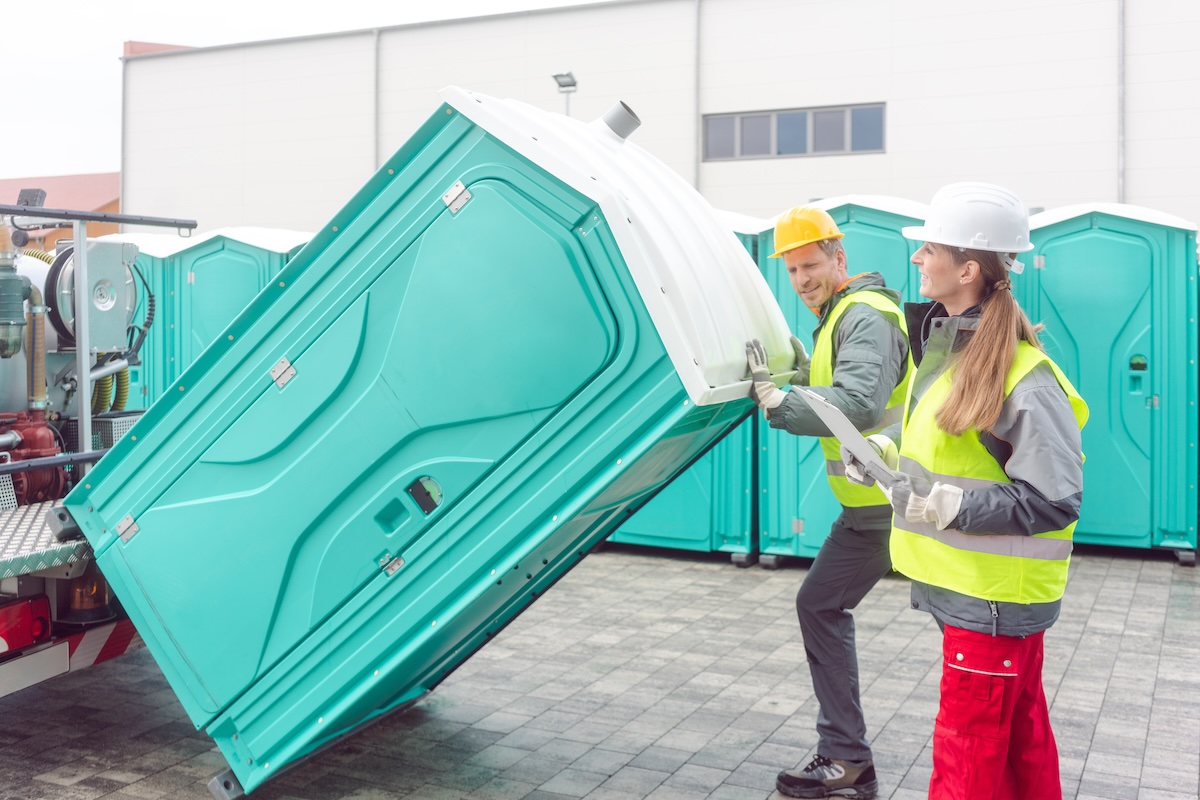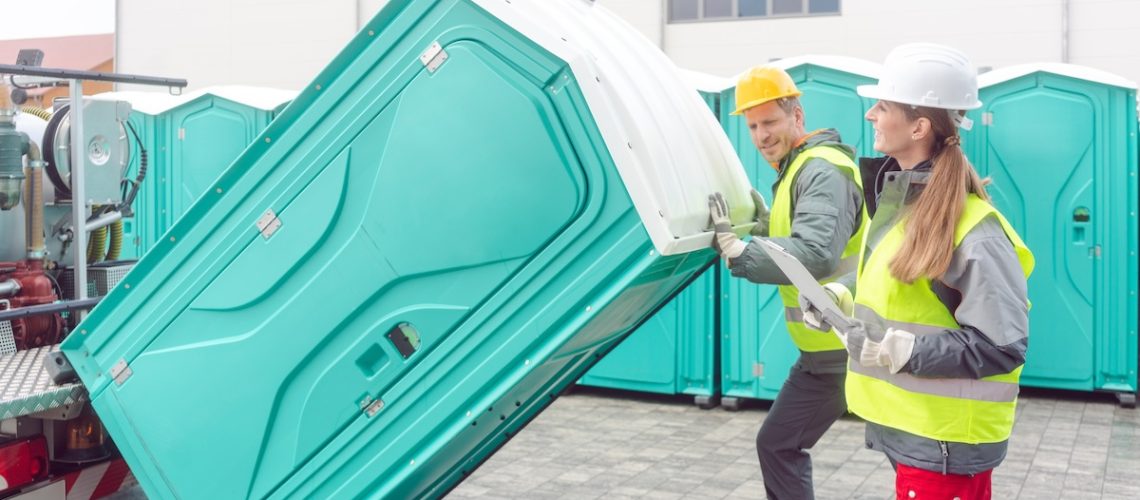When people think about event planning or job site logistics, restrooms usually aren’t the first detail that comes to mind. But ask anyone who’s ever waited in a half-hour line for a porta potty at a festival, or worked a 10-hour shift on a construction site with too few units, and they’ll tell you—nothing can sour the experience faster. A caterer runs late and people shrug, the DJ misses a song and everyone laughs it off, but restrooms? That’s the kind of thing people will grumble about all day. It’s also one of the few logistics that can make or break morale—what feels minor on paper can feel monumental in practice.
It’s the kind of oversight that seems small until you’re in the middle of it. Suddenly, the wedding everyone spent months planning is remembered for the line stretching down the lawn, or the crew’s productivity dips because they’re stuck waiting instead of working. Nobody brags about flawless restroom logistics, but everyone remembers when it’s done wrong.
The good news is that there are mathematic formulas you can use to help estimate the number of portable restrooms you should plan for. With the correct number of portable units, you can keep wait times short, meet health and safety standards, and protect your event or job site from last-minute emergencies. People might not compliment you directly on getting it right, but they’ll be more relaxed, more engaged, and more likely to focus on the actual purpose of the gathering. That quiet success—when everything just works—is usually the result of a little foresight in places that many people overlook.
That said, these guidelines are not necessarily universal. U.S. government and OSHA regulations set minimums, but local codes, event dynamics, and site conditions all play a role. Always double-check the latest standards and consult with your rental provider for recommendations tailored to your situation.

Before we continue, let’s be honest here: nobody pulls out their phone a couple nights before a big event excited to research portable restroom ratios. You’ve probably got a hundred much more glamorous and/or interesting details competing for your attention. But taking 10 minutes to get this part right can mean the difference between guests raving about your party or workers staying productive on site—and people quietly griping about long lines that could’ve been avoided. You don’t have to love the topic—you just have to know you’re covered! With that out of the way, let’s continue…
Core Sizing Guidelines
The most common rule of thumb for portable restroom rentals is simple:
- Events: One standard unit per 50 guests for up to four hours of event time.
- Construction sites: One unit per 10 workers for a 40-hour work week (OSHA requirement).
At first glance, this math seems straightforward enough. But the real world rarely fits into neat averages. Think about the differences between a wedding reception where alcohol is served, a music festival with multiple peak periods, or a job site with split shifts. Each requires an adjustment. That’s the part people often overlook—real life is messier than any chart. The “one per 50” rule is a starting point, not an endpoint, and knowing when to bump those numbers up can save you from bigger problems.
Adjusting for Event Duration
Time is one of the biggest multipliers when estimating restroom needs. The longer your event or shift, the more each person will need to use the facilities.
- 2–4 Hours: The baseline “1 per 50” guideline usually holds.
- 4–8 Hours: Increase by about 15–20% to avoid long lines.
- 8+ Hours: Plan for nearly double the baseline, especially if food and drinks are served.
Construction sites follow a similar logic—more hours means more usage, and failing to plan for that can trigger both worker dissatisfaction and compliance issues.
Event Type Considerations

Usage rates vary significantly depending on what people are doing and what’s being served.
Weddings & Private Events
Guests expect comfort and convenience. Alcohol and sit-down meals increase usage. Extra units or upscale restroom trailers for weddings and higher-end events are often worth the investment.
People dress up for these occasions, and nobody wants to navigate long lines in heels or tux shoes. Adding a touch of comfort here—like luxury trailers—elevates the whole atmosphere in a way guests quietly appreciate.
Festivals & Concerts
Larger crowds, heavier foot traffic, and more frequent use. Consider clustering units in multiple areas to spread out lines.
What happens in practice is that crowds move in waves—one set surges after a band finishes, another when food trucks hit their stride. By spreading units out, you can cut wait times and keep people where they want to be: enjoying the show instead of standing in line.
Construction/Industrial Sites
OSHA requirements set the floor, but high-turnover crews, extreme weather, or remote locations may require more.
Anyone who’s worked in the field knows that meeting the bare minimum doesn’t always translate to comfort or efficiency. When workers are spread across large sites or dealing with blazing sun or cold weather, extra units aren’t a luxury—they’re part of keeping the day moving smoothly.
Sports Events
Sudden peak times (like halftime or post-race) create surges. A few extra units can make the difference between smooth flow and bottlenecks. Spectators and athletes both tend to move in packs, which means demand spikes all at once. Naturally, it’s the kind of thing many organizers will only underestimate once—after that, they learn that adding a couple of extra restrooms is far cheaper than losing goodwill when people spend intermission standing in line.
ADA & Specialty Needs
Planning for Accessibility
Federal law requires that at least 5% of units, or at least one unit per 20, be ADA-compliant. These larger, accessible restrooms are designed for wheelchair users and others who need extra space.
It’s not just about meeting legal obligations—it’s about making sure everyone at your event or site is accommodated. Some situations may also call for:
- Handwashing Stations: Especially if food is served.
- Luxury Restroom Trailers: For weddings, VIP events, or corporate functions.
- Specialized Units: High-rise restrooms or lift-able models for construction projects.
Quick Reminder
While the formulas and examples here are based on industry standards, OSHA and local regulations can and do change. Always check the latest requirements in your state or municipality to stay compliant.
Figuring Out the Numbers the Easy Way
Rules of thumb are useful, but sometimes it helps to see the math laid out in front of you. That’s where a simple calculation chart can be very handy indeed, since it turns the “one per 50” guideline into a quick reference you can glance at while planning. And while charts might seem overly technical for a guide about temporary outdoor toilets, the point here isn’t to make you an honorary OSHA auditor. It’s to give you something solid enough to base a rental decision on, without wading through government documents on a Thursday night. (That said, rules do change—OSHA updates their requirements from time to time—so it’s always smart to double-check the latest standards before you confirm your rental order.)
Recommended Portable Restroom Counts
Here’s a simplified chart you can use when planning your event or site. It shows how guest count and event length affect the number of standard units recommended.
(Note: This is an example planning tool, not a legal standard. Always verify with the latest OSHA or local regulations.)
| Guest Count | 2–4 Hours | 4–8 Hours | 8+ Hours |
|---|---|---|---|
| 50 | 1 | 2 | 2+ |
| 100 | 2 | 3 | 4+ |
| 250 | 5 | 6–7 | 8+ |
| 500 | 10 | 12–14 | 16+ |
| 1,000 | 20 | 24–28 | 32+ |
How to Read This:
- Green = Adequate: You’re safely within industry guidelines.
- Yellow = Borderline: You’ll probably get by, but expect longer lines at peak times.
- Red = Underserved: You risk complaints, compliance issues, or both.
It’s tempting to think this chart is only about guest satisfaction—nobody likes waiting in line—but the stakes are higher than that. On a construction site, failing to meet OSHA minimums can result in fines. At a large public event, not having enough restrooms can become a safety and sanitation concern, not just an inconvenience.
One way to think of it: you wouldn’t under-plan tables at a wedding reception or leave half your workforce without safety helmets. Restroom access is part of the same picture.
What Happens If You Accidentally Undershoot the Numbers?
Having too few units doesn’t just inconvenience people, it creates ripple effects that many planners underestimate. Lines get longer, tempers rise, and suddenly the great food or entertainment you arranged is overshadowed by the most basic facility not keeping up. Guests remember that far longer than the playlist.

On a job site, the stakes are even clearer. OSHA requires minimum ratios for a reason. If inspectors find a shortage, fines follow—and even if they don’t, worker morale takes a hit when crews spend more time waiting in line than actually working. It’s not just about compliance, it’s about productivity. A few extra units almost always cost less than the lost labor hours of twenty people queuing at once.
Cutting Corners Can Become More Expensive
There’s also the issue of last-minute scrambling. Ordering emergency units on event day usually means paying premium delivery fees, and even then availability isn’t guaranteed. The rental companies keep a fleet ready, but in peak season those trucks may already be rolling to other sites. A little extra planning upfront saves you from gambling with shortages later.
One planner I worked with summed it up nicely: nobody remembers if you rented one too many, but they’ll never forget if you rented two too few. That kind of hindsight comes with a price tag.
Why It’s Better to Plan Ahead Than Shuffle Units Later
Once pre-planned units are in place, resist the urge to move them around on the fly. Planning up front that includes a small cushion of extras are almost always more effective than reactive mid-course adjustments. A mid-event “fix” can end up shifting the problem and making it larger rather than solving it. For example:
- Moving units around: Someone thinks they’re helping by dragging a couple of porta potties closer to the food line. That leaves the original area short, and now both spots are backed up. It’s a classic case of robbing Peter to pay Paul—what looks like a quick improvement in one spot just spreads the strain somewhere else.
- Reallocating resources based on perception rather than data: Midway through, an organizer decides too many are sitting “unused” at one end, so they reduce capacity there. Later, when the crowd shifts, that area becomes a choke point. Crowd behavior isn’t static. People ebb and flow depending on food service, entertainment, or break times, and what looks “empty” now can be jam-packed an hour later. It’s why planners who rely on gut feeling instead of the math often end up chasing the problem instead of staying ahead of it.
A better approach is to trust the plan you laid out in advance and accept that usage isn’t perfectly even across every hour of the day. A few quiet moments by certain units don’t mean they aren’t needed—they’re the buffer that prevents a rush from turning into a bottleneck later. In other words, it’s not necessarily wasted capacity.
You can think of this like traffic lanes on a highway. Just because the right lane looks emptier at one moment doesn’t mean you should close it down. As soon as a surge comes, you’ll wish it was still open. Portable restrooms work the same way—the extra capacity you thought was sitting idle usually becomes the difference between smooth sailing and a line stretching down the block.
ADA and Specialty Units
ADA requirements—for example, having at least 5% accessible units, or one per 20—sometimes gets treated like a box to check. But it’s more than that. At weddings and family gatherings, accessible units often make the difference for elderly guests or anyone with mobility challenges. On public sites, it’s a legal safeguard that protects you from complaints or lawsuits.
A single accessible unit can turn what might have been an obstacle into a seamless part of someone’s day. It’s the kind of detail people rarely mention directly, but they notice in the way they feel welcome.
Beyond compliance, the presence of specialty units changes how people experience your event. Renting portable outdoor “sinks” (i.e. handwashing stations) mean food feels more approachable. Luxury trailers at corporate events elevate the atmosphere and, in a subtle way, tell attendees you thought of everything. That small detail can carry more weight than most organizers realize.

It’s almost like setting the tone without saying a word: a simple handwashing station reassures parents with kids, while a high-end restroom trailer can put a professional polish on a gathering that might otherwise feel ordinary. These add-ons are signals of care. Guests often can’t explain why an event felt “well put together,” but these small details are usually part of the reason.
Planning With Regulations in Mind
Everything in this guide is drawn from common industry standards, but regulations do shift. OSHA updates worker requirements periodically, and local municipalities often add their own layers. A county fairground may enforce stricter ratios than a wedding venue, and construction projects sometimes face added inspection points tied to state-level labor rules.
That’s why the safest approach is to treat charts and formulas as a starting point, not the final word. Before confirming your rental order, take a moment to check current OSHA standards and any local codes that apply. Your rental company should be able to point you toward the most recent guidelines, but responsibility ultimately rests with the event organizer or site manager.
Pulling the Details Together
By now, it’s clear that portable restroom planning is more than just plugging numbers into a formula. Charts and ratios are a good starting point, but the real decisions happen when you layer in event length, crowd dynamics, food and alcohol service, accessibility, and even the quirks of the venue. It’s not unlike setting a budget—you start with a guideline, but then you account for what’s unique to your situation.
Why It Pays to Think Ahead

The truth is, restrooms only become a topic of conversation when something goes wrong. Nobody leaves a wedding or job site raving about how perfectly the porta potties were planned, but they’ll definitely talk about the long lines or the lack of handwashing stations. That’s why experienced planners treat this as a quiet insurance policy. A few extra units rarely break the budget, but too few can break the experience.
And yes, it may feel excessive to double-check OSHA standards or local codes when you’re already juggling everything else. But one glance at the latest requirements can save you from fines or last-minute headaches. Rules do change, and they change faster than most people realize.
The Takeaway
So here’s the takeaway—use the chart and guidelines as a framework, but don’t stop there. Think about how long your event will run, what kind of crowd you’ll have, and whether the details you add (like ADA units or handwashing stations) will make the experience smoother for everyone. Then, before finalizing anything, confirm that you’re meeting the most recent OSHA and local requirements.
That way, when the big day comes—or the project kicks off—you’ll know you’ve done the math, covered compliance, and left nothing to chance. Guests, workers, and inspectors alike will appreciate the difference, even if nobody mentions it out loud.
And just as a final note—regulations do have a certain way of changing quietly in the background, so take a quick peek at the latest OSHA or local rules before you lock things in. It’s the kind of 5-minute check that keeps everything running smoothly, and it’ll give you one less thing to worry about when the crowd shows up.
At the end of the day, it’s quite possible that nobody’s going to thank you for perfect restroom planning—but they will thank you for creating a smooth, stress-free experience. And if we can help you avoid even one of those “wish we’d thought of that sooner” moments, then this little guide has done its job. Because when the only thing people remember about your restrooms is that there wasn’t a line… that’s when you know you got it exactly right.


